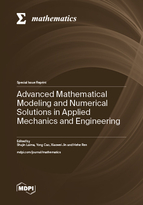Advanced Mathematical Modeling and Numerical Solutions in Applied Mechanics and Engineering
A special issue of Mathematics (ISSN 2227-7390). This special issue belongs to the section "Engineering Mathematics".
Deadline for manuscript submissions: closed (31 August 2023) | Viewed by 46122
Special Issue Editors
Interests: numerical simulation in fluid dynamics; wind engineering; bridge engineering; fluid mechanics; fluid-structrure interaction; machine learning
Special Issues, Collections and Topics in MDPI journals
Interests: computational fluid dynamics; turbulence simulation; wind engineering; extreme weather; bluff-body aerodynamics
Special Issues, Collections and Topics in MDPI journals
Interests: bluff body aerodynamics; data-driven modeling for fluid mechanics; physics-informed machine learning for scientific computing
Special Issues, Collections and Topics in MDPI journals
Interests: multi-scale wind field simulation methods; high-resolution typhoon numerical simulation and physical mechanism analysis; airport engineering and offshore wind turbine disaster prevention and mitigation
Special Issues, Collections and Topics in MDPI journals
Special Issue Information
Dear Colleagues,
Mathematical modeling and numerical solutions are the mainstream way to represent and predict the complex scientific and engineering problems nowadays, leading to the analysis and design of engineering products and systems. It is significantly supported by the fast development of advanced numerical methods and high-performance computers. The computer methods include mathematical models and numerical algorithms related to finite element, finite difference, finite volume, and meshless discretization method. In addition to the traditional methods, artificial intelligence technology is rapidly popularized in the wide fields of science and engineering, and has enormous potential for solution of the complex physical problems.
This Special Issue intends to collect advances in development and use of mathematical models and numerical methods for the solution of problems in engineering and the sciences. The range of appropriate contributions is very wide, and includes papers on the mathematical modeling and numerical simulations in all aspects of mechanics, including solid (structures), fluids, and multiphysics. The novel mathematical models and computational methods based on finite volume, finite element, finite difference, meshless discretization methods, artificial intelligence, parallel computing, as well as probabilistic and stochastic approaches are also useful for this Special Issue.
Prof. Dr. Shujin Laima
Prof. Dr. Yong Cao
Dr. Xiaowei Jin
Dr. Hehe Ren
Guest Editors
Manuscript Submission Information
Manuscripts should be submitted online at www.mdpi.com by registering and logging in to this website. Once you are registered, click here to go to the submission form. Manuscripts can be submitted until the deadline. All submissions that pass pre-check are peer-reviewed. Accepted papers will be published continuously in the journal (as soon as accepted) and will be listed together on the special issue website. Research articles, review articles as well as short communications are invited. For planned papers, a title and short abstract (about 100 words) can be sent to the Editorial Office for announcement on this website.
Submitted manuscripts should not have been published previously, nor be under consideration for publication elsewhere (except conference proceedings papers). All manuscripts are thoroughly refereed through a single-blind peer-review process. A guide for authors and other relevant information for submission of manuscripts is available on the Instructions for Authors page. Mathematics is an international peer-reviewed open access semimonthly journal published by MDPI.
Please visit the Instructions for Authors page before submitting a manuscript. The Article Processing Charge (APC) for publication in this open access journal is 2600 CHF (Swiss Francs). Submitted papers should be well formatted and use good English. Authors may use MDPI's English editing service prior to publication or during author revisions.
Keywords
- mathematical modeling
- numerical simulation
- mechanics
- engineering
- finite element method
- computer fluid dynamics
- machine learning
- reduced order modelling
- inverse problems







